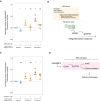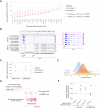This is a preprint.
IGHMBP2 deletion suppresses translation and activates the integrated stress response
- PMID: 38168189
- PMCID: PMC10760061
- DOI: 10.1101/2023.12.11.571166
IGHMBP2 deletion suppresses translation and activates the integrated stress response
Update in
-
IGHMBP2 deletion suppresses translation and activates the integrated stress response.Life Sci Alliance. 2024 May 21;7(8):e202302554. doi: 10.26508/lsa.202302554. Print 2024 Aug. Life Sci Alliance. 2024. PMID: 38803225 Free PMC article.
Abstract
IGHMBP2 is a non-essential, superfamily 1 DNA/RNA helicase that is mutated in patients with rare neuromuscular diseases SMARD1 and CMT2S. IGHMBP2 is implicated in translational and transcriptional regulation via biochemical association with ribosomal proteins, pre-rRNA processing factors, and tRNA-related species. To uncover the cellular consequences of perturbing IGHMBP2, we generated full and partial IGHMBP2 deletion K562 cell lines. Using polysome profiling and a nascent protein synthesis assay, we found that IGHMBP2 deletion modestly reduces global translation. We performed Ribo-seq and RNA-seq and identified diverse gene expression changes due to IGHMBP2 deletion, including ATF4 upregulation. With recent studies showing the ISR can contribute to tRNA metabolism-linked neuropathies, we asked whether perturbing IGHMBP2 promotes ISR activation. We generated ATF4 reporter cell lines and found IGHMBP2 knockout cells demonstrate basal, chronic ISR activation. Our work expands upon the impact of IGHMBP2 in translation and elucidates molecular mechanisms that may link mutant IGHMBP2 to severe clinical phenotypes.
Keywords: ATF4; CMT2S; IGHMBP2; SMARD1; integrated stress response.
Conflict of interest statement
COMPETING INTEREST STATEMENT The authors declare no competing interests.
Figures





Similar articles
-
IGHMBP2 deletion suppresses translation and activates the integrated stress response.Life Sci Alliance. 2024 May 21;7(8):e202302554. doi: 10.26508/lsa.202302554. Print 2024 Aug. Life Sci Alliance. 2024. PMID: 38803225 Free PMC article.
-
ABT1 modifies SMARD1 pathology via interactions with IGHMBP2 and stimulation of ATPase and helicase activity.JCI Insight. 2023 Jan 24;8(2):e164608. doi: 10.1172/jci.insight.164608. JCI Insight. 2023. PMID: 36480289 Free PMC article.
-
A novel IGHMBP2 variant and clinical diversity in Vietnamese SMARD1 and CMT2S patients.Front Pediatr. 2024 Feb 13;12:1165492. doi: 10.3389/fped.2024.1165492. eCollection 2024. Front Pediatr. 2024. PMID: 38415210 Free PMC article.
-
The molecular mechanisms that underlie IGHMBP2-related diseases.Neuropathol Appl Neurobiol. 2024 Aug;50(4):e13005. doi: 10.1111/nan.13005. Neuropathol Appl Neurobiol. 2024. PMID: 39119929 Review.
-
Disease Mechanisms and Therapeutic Approaches in SMARD1-Insights from Animal Models and Cell Models.Biomedicines. 2024 Apr 11;12(4):845. doi: 10.3390/biomedicines12040845. Biomedicines. 2024. PMID: 38672198 Free PMC article. Review.
References
-
- Bohnsack KE, Yi S, Venus S, Jankowsky E, Bohnsack MT. 2023. Cellular functions of eukaryotic RNA helicases and their links to human diseases. Nat Rev Mol Cell Biol 24: 749–769. - PubMed
Publication types
Grants and funding
LinkOut - more resources
Full Text Sources
Molecular Biology Databases
